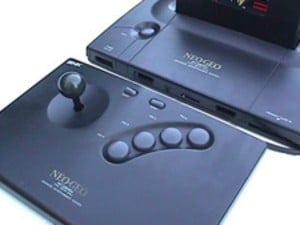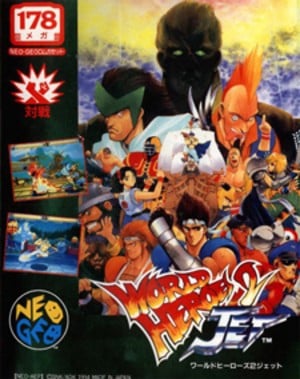
Never before had a console screamed 'elite'; when it was first released it comfortably outstripped the performance of rival machines and made good on SNK's promise that you could have an arcade in your living room. Then again, there was a reason the company could make this proud boast - the Neo Geo WAS an arcade in your living room. The home console (known as the AES - which stands for 'Advanced Entertainment System') was identical to the MVS (Multi Video System), which was the arcade hardware that brought us such classics as Metal Slug, King of Fighters and Fatal Fury.
Such power obviously came at a price. It may have been released to the market at the same time as the more technically humble Megadrive/Genesis and SNES, but it simply wasn't in the same league when it came to accessibility. The machine itself would set you back a cool $649.99 and games could be $200 each - or more. This was well out of the reach of most kids and therefore the machine only attracted hardcore gamers with large disposable incomes; needless to say SNK didn't trouble Sega and Nintendo when it came to market share.
However, if you were rich enough to take the plunge a whole world of gaming goodness awaited you. The insanely powerful hardware could produce visuals the likes of which had never been seen before on a home system; massive characters showcasing stacks of animation, silky-smooth sprite scaling and rotation, booming CD-quality soundtracks... OK, so each game cost $200 but back in the early '90s, that didn't seem like such a bad deal when you consider that the average SNES release could set you back $50-$70 and didn't look half as impressive to your envious friends.

Sadly, the one thing the Neo Geo didn't possess was strong third party support. SNK released a tremendously large library of games for the machine, but most developers refused to take the plunge, possibly deterred by the small home market and lack of commercial opportunities. Some might argue that it didn't matter, as SNK's games were of such a high standard they made most home console products look pathetically underpowered in comparison. Nothing illustrates this more effectively than the company's famous long running feud with fellow arcade veteran Capcom.
When Capcom released Street Fighter II in the early '90s it started a revolution in the coin-op world - brawlers were back. Keen to muscle in on this newfound appreciation for one-on-one fighters, SNK decided to make the genre its own and began to create franchises such as Fatal Fury, Art of Fighting and Samurai Shodown. Rumour has it that the company successfully poached several key Capcom staffers to produce many of its new fighting games.
For a while it seemed that Capcom was unstoppable, but when SNK published King of Fighters '94, the unthinkable happened: Street Fighter II was no longer seen as the fighting game of choice. For the next decade Japanese arcade fanatics would wait with eager anticipation for the next KOF instalment, while Capcom's fighters were met with a far less enthusiastic reception. Even today the KOF series attracts a massive following in the East.

In an effort to make the machine a more viable retail proposition SNK introduced a CD-ROM based version in the middle of the 1990s, but thanks to high hardware prices, disappointing loading times and poor build quality, it sadly didn't receive the support that possibly might have been expected. Ironically, the cartridge system outlived its CD-ROM counterpart.
The most amazing aspect of the Neo Geo was its longevity: the MVS was discontinued in 2004, making it one of the longest supported consoles in the history of videogaming. By the end of its lifespan the technical limitations were telling, but it still remains the best system on which to experience true 2D brilliance. Games like Mark of the Wolves and Last Hope (the last official release for the system) show just how capable this amazing console was.
Although the AES and MVS systems were based on the exact same technology, they were not compatible. Therefore, AES carts tend to sell for more than MVS ones these days though. MVS releases were more widespread because arcade operators supported the system way into the '90s. A good example of this disparity is the value of the AES version of Metal Slug, which is well into the thousands. The MVS edition is much cheaper and more common.

One interesting facet of the NeoGeo system is the pioneering use of memory cards. The idea was that you could play a game in the arcade, save your progress on your card and then keep playing when you returned home to the AES system. It was an interesting idea but one would have to ask why you would play a game in the arcade that you already owned at home.
Now that the Virtual Console has been blessed with a Neo Geo channel, it's possible to enjoy this vintage console for a far more reasonable price. One can only hope that Nintendo will allow some kind of hard drive support for the Wii, as some of the later Neo Geo games are pretty hefty in terms of memory use.
Comments 29
Yeaha!!!!
Neo Geo was one of the best Systems ever!!!!
Nice to fully read the history of the NeoGeo; a system I barely knew about back in the 90's. I remembered it had a whole slew of Fighter games and a Portable system as well.
I look forward to seeing more good games to come to the VC.
I've never touched a NeoGeo console let alone played one. They were just way too expensive and I've made do with ports on Saturn and PlayStation (I used to pay about £50 each for the Japanese KoF '97 - '01). The other games on NeoGeo just never interested me (except for Garou: Mark of the Wolves which I never played but need to play some time).
I'm really glad NeoGeo is on Virtual Console for such a ridiculously cheap price. Glad to see they aren't once a month like N64 games. Come on Samurai Shodown! Although I think my first Samurai Shodown game will be the second one to be honest.
I used to play this NeoGeo game in the arcade where you were a samurai or some kind of swordsman, and you would collect these orbs from defeated enemies to change into different things. No, it wasn't Magician Lord. Does anyone know which game I'm talking about? I have been searching for this game for a long time, if anyone knows the name please let me know.
I can't believe Video Games had advertisements like that before. XP
The reason the N64 games normally come only once a month is because they up-convert the games to 480p and smooth / re-do some of the textures.
All great stuff. However, when are we going to get these cool Neo Geo fighting games?
Great job with these hardware focus articles!
It really adds depth to your website and I think alot of people would be interested in reading more articles like these.
Jimmy, that game is Sengoku I&II.
I played a lot to the second on arcades.
I dreamt about havin a neogeo when i was 13/14 reading all those CVG's and EGM's. I only got mine since 2006 and i was really happy i could afford one finally . I own a AES now and 15 games
Anyway nice article to bad you didn't talk about the architecture that made this system so unique
it's 16bit + 8bit sound processor ... often claimed to be a 24bit system while it only is a 16bit power mongoose
and that trademark dog they used
just cool .. way cool
Thank you, Disquete Enmascarado. I have finally found it! I am now playing and reliving some of my childhood!
Le Bla: That's not even the worst ad I've seen. The Sega Saturn once ran an ad with a naked woman barely covered by Saturn system and controllers, the caption reading something like "there's a naked woman on this page, but you won't even notice" followed by a sales pitch for the Saturn and its supposed awesomeness.
As for the article, I found it very interesting, having barely even heard of the NeoGeo before the VC came out with it.
Thanks man, and a pretty good hardware focus. I am really glad that the VC is getting NG games.
If not for all the gaming magazines I frequented at the time (and still do), I wouldn't have known the Neo Geo existed. A pretty good system all in all, but in retrospect, I wouldn't have traded it for my SNES.
I played Samurai Showdown once on an orginal neogeo, great game, hope it comes to vc soon.
I'm sad that there haven't been any new NeoGeo games on Virtual Console this year. I keep expecting a new one (like Samurai Shodown) every week.
I should say the Neo Geo Launch price was $649.99 which is £321.91. I wounder how many peope just got this for the sake of it? I would rather have a ps3 these days.. i wounder how much complaning was done over this price? 24-Bit for £321.91 i dont think so..
compared to other games back then, neo geo could have probly been the ps3 of its time!(in terms of graphics) remember this same machine was capable of playing KOF'99! --imagine if it were made n '93! lol
Ahhhh, the Neo-Geo. I plan on getting an MVS arcade set when I have some cash lying around. Yes I have some big plans once I hit 18
Ive never played this system before. but the fighting games look crazy fun.
It's hard for me to want to Download these game's on the VC for 900 Wii points each, when SNK has put out a Disc for the Wii with 16 Neo Geo game's on it for only $29.95. It kind of kills them on the Virtual Console for me.
Neo Geo - Aah Bliss. I remember years back going to a house in Purley, South London to purchase an imported Sega Genesis machine. The guy also had an imported Neo Geo and I was totally blown away by the machine until the astronomical price was mentioned.
I then bought a Sega Saturn (which was later sold on Ebay) just to play Metal Slug. In fact the Sega Saturn was the king of 2-D shooters.
My favourite games Neo Geo games are the following:
Metal Slug series (the whole Metal Slug series is now widely available to buy),
Alpha Mission II,
Pulstar,
Bust-a-Move
Magic Drop
Twinkle-Star sprites
Last Resort
and the most sought after game IMO is/was Ironclad aka Bri;Kinger
Nuff Said
Though I never played NeoGeo (My start of my gaming career was my Pokémon Silver a year before Pokémon Crystal was released.), I read about pricey consoles.
3rd place is the Sega Saturn, which costs about $400.
2nd place has the PlayStation3 with prices around the $400-600 range (even though I think it could cost around 800).
1st place carries the NeoGeo with aproximately $650.
(By the way, is it not odd that a GameCube, outperforming the pricier Saturn and NeoGeo, costs only $99?)
NeoGeo was way ahead of its time in its era and the cost of that was a high price for the console and its cartridges. You just couldn't get arcade perfect ports on any other home console at the time.
Yeah, it was expensive. I remember showing it to my mom and dad as a way to get them to buy me a different system. "At least I'm not asking for this!"
Anyway, the cost of a PS3 isn't a good comparison.
For one thing, at the time, there was nothing even close to the same performance as the NEO GEO. It's not "arcade perfect ports" it is the actual arcade! These were the same games that were in the arcade, not retooled, reprogrammed versions. Today, even if the PS3 is the most advanced and powerful system on the market, it really isn't that far ahead of the 360. Honestly, in side-by-side shots of the same game, most people can't tell the difference. Not so for the NEO GEO when it came out. It was very obvious which was which.
These days, the home systems are on par with the arcade systems. The top home systems are in some cases better graphically than the arcade. But if there were some system that came out today with the same advantage in graphics that the Neo Geo enjoyed over the SNES and Genesis, it would be worth probably about $1200. And there would still be buyers.
Third, you've got to look at the inflation rate. How much would the Neo Geo cost in 2008 dollars? $600 in 1990 is equal to about $1000 today. So a system released today, would cost about a $1000, or $400 more than a PS3. Looking at the cost of the SNES or Genesis, $299 in 1990 is equal to about $500 today. Or, the PS3 compares favorably to the cost of the SNES or Genesis when inflation is taken into account. These are rough estimates made using "Tom's Inflation Calculator" that I found on Google.
At any rate, I think $600 was a fair price for the Neo Geo back in 1990 because it was so far ahead of all the other systems that were available at the time.
Are there really any games worth buying other than Metal Slug, Samurai Shodown and King of Fighters that aren't available in one of the collections? That's what I thought.
Yes, try Garou: Mark of the Wolves, Last Blade, Last Blade 2, Shock Troopers, Twinkle Star Sprites, Blazing Star, Waku Waku 7
I got Garou: Mark of the Wolves recently on XBox 360. Its okay, not as great as its made out to be IMO although I am sure I just think that because I hadn't played it before; if I had played it ten years ago when it was made I would probably have enjoyed it a lot more.
Personally, I think paying 900 points for each of these games is a bit of a rip off, especially when you can get SNK arcade Classics Vol.1 as well as Metal Slug Collection and Samurai Showdown Collection for probably the same price!
Tap here to load 29 comments
Leave A Comment
Hold on there, you need to login to post a comment...